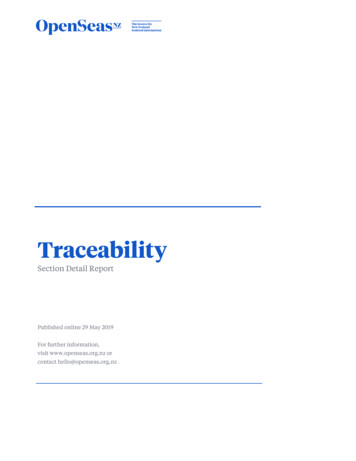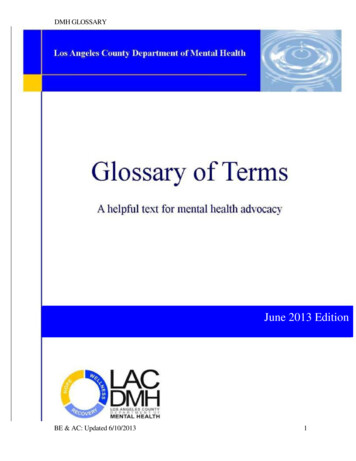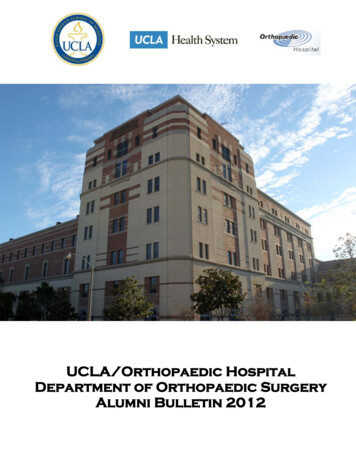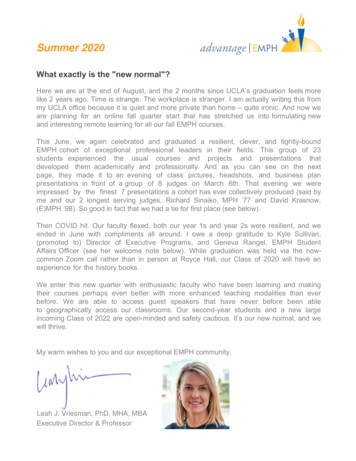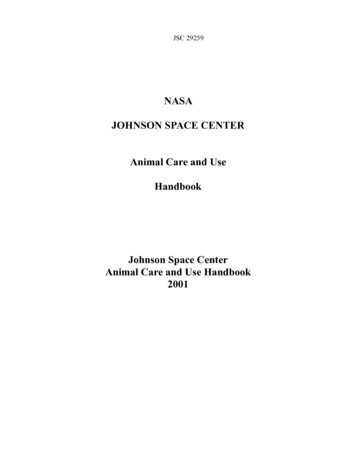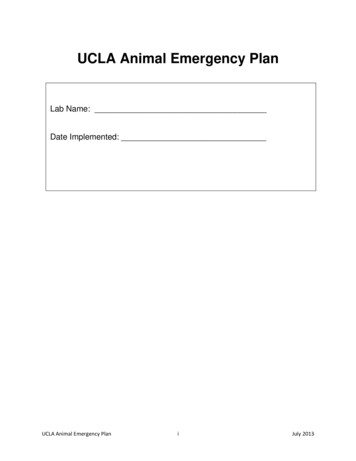
Transcription
UCLA Animal Emergency PlanLab Name:Date Implemented:UCLA Animal Emergency PlaniJuly 2013
UCLA Animal Emergency PlaniiJuly 2013
THIS PAGE INTENTIONALLY LEFT BLANK.UCLA Animal Emergency PlaniiiJuly 2013
Record of Revisions/Reviews(to be reviewed annually)Originally Released: 7/15/2013Review/RevisionUCLA Animal Emergency PlanReviewed byDateivJuly 2013
Table of ContentsChapter 1: Introduction . 1-11-1: Critical Components . 1-11-2: Plan Components . 1-11-3: Animal Program Emergency Response Planning . 1-2Chapter 2: Who is in charge? . 2-1Chapter 3: When will the plan be activated? . 3-13-1: Animal Activism Event . 3-23-2: Bite, Scratch, & Splash . 3-33-3: Bomb Threat . 3-53-4: Chemical Hazard Spill or Exposure . 3-93-5: Biohazard Spill or Exposure. 3-103-6: Radiation Spill or Exposure. 3-123-7: Civil Disturbance (Disgruntled Employee, Intruder/Trespasser) . 3-143-8: Critical Animal Room Temperatures, Humidity, and Directional Airflow (BuildingAutomation Systems (BAS) and HVAC Failure). 3-173-9: Earthquake . 3-193-10: Facility Access . 3-203-11: Fire. 3-223-12: Flood/High Water . 3-243-13: High Wind (Tornado, Hurricane, Derecho). 3-263-14: Medical Emergency . 3-283-15: Storms . 3-303-16: Strange Odor . 3-313-17: Structural Damage . 3-323-18: Telecommunications Failure . 3-343-19: Utility Failure – Electric Power, HVAC . 3-353-20: Utility Failure – Sewer, Water . 3-37Chapter 4: What actions will be taken? . 4-14-1: Scientific Integrity of Ongoing Studies Can Be Maintained - Preserve All or Mostof the Animals . 4-14-2: Scientific Integrity of Ongoing Studies Cannot Be Maintained - Preserve OnlyUnique and Irreplaceable Laboratory Animals (UILA) . 4-1Chapter 5: How will the necessary actions be carried out? . 5-35-1: Communication during an Emergency/ Disaster Event . 5-45-2: Euthanasia Guidance for Disaster Events . 5-45-3: Evacuation from Large Animal Surgery, Imaging & Special Techniques Areas . 5-65-4: Animal Program Staff Preparedness Information. 5-75-5: Animal Program Status Report Information . 5-9UCLA Animal Emergency PlanvJuly 2013
5-6: Animal Program After-Action Report (AAR) . 5-95-7: Calculating Minimum Water Requirements . 5-115-8: Emergency Alert Notification Systems . 5-125-9: Emergency Animal Care Resources . 5-135-10: Information Technology Systems Failure (Computer, Email, Inter/Intranet,Servers) . 5-135-11: Staffing Shortage Planning Guidance . 5-145-12: Transportation Emergencies & Supply Failure (Weather, Road Blocks, PublicTransportation Outage) . 5-165-13: Triage Guidance for Disaster Events . 5-175-14: Media and FOIA Inquiries . 5-185-15: Facility Alarm Set Points . 5-185-16: Telecommunications Systems . 5-15-17: Online Resources & Links. 5-2Chapter 6: Training and Documentation. 6-16-1: Lab Membership . 6-16-2: Critical Resources and Continuity of Operations . 6-2Chapter 7: Glossary of Acronyms . 7-1UCLA Animal Emergency PlanviJuly 2013
Chapter 1: IntroductionThis plan pertains to unplanned events that could cause death or major injuries toemployees (or animals), disrupt operations, cause physical or environmental damage,or threaten our facility’s financial standing or public image (i.e., the Federal EmergencyManagement Agency definition of a disaster). The goal of this document is tosummarize the disaster-preparedness procedures that have been established and toaddress the requirements for such a plan put forth by the USDA Animal Plant HealthInspection Service (APHIS) and the 8th edition of the NRC Guide for the Care and Useof Laboratory Animals (The Guide).On December 31, 2012, APHIS published a final rule that requires all dealers,exhibitors, intermediate handlers, carriers, research facilities, and other entitiesregulated by the Agency under the Animal Welfare Act (AWA), to take additional stepsto better prepare for potential disaster situations. Registered entities are required todevelop a plan for responding to and recovering from emergencies most likely tohappen to their facility, as well as train their employees on those plans and review theplans annually.The Guide requires that animal facilities have a disaster plan that: should define the actions necessary to prevent animal pain, distress, anddeaths due to loss of systems such as those that control ventilation, cooling,heating, or provision of potable water. If possible the plan should describe howthe facility will preserve animals that are necessary for critical research activitiesor are irreplaceable Animals that cannot be relocated or protected from theconsequences of the disaster must be humanely euthanized. The disaster planshould identify essential personnel who should be trained in advance in itsimplementation. (p. 35)1-1: Critical ComponentsTherefore a Disaster Plan should ensure the protection of three critical components:1. Environmental Health and Safety- to protect personal and environmental health ofboth employees and those in the surrounding community.2. Animal Welfare- to ensure cared and/or humane euthanasia is provided.3. Business Continuity- to ensure critical and unique animal resources (strains, data,and tissues) are preserved, and research operations can resume following adisaster.1-2: Plan ComponentsThis document speaks to the APHIS and Guide requirements for such a plan andcontains the following four sections:UCLA Animal Emergency Plan1-1July 2013
Who is in charge?When will the plan be activated?What actions will be taken?How will the necessary actions be carried out?1-3: Animal Program Emergency ResponsePlanning1-3-1: MITIGATIONWhile many emergency and disasters cannot be entirely prevented, the impact can bemitigated by implementing an effective plan that encompasses preparedness, response,and recovery. It is an on-going process that is not finished once the disaster plan iswritten and implemented. It is also an iterative process involving training, testing,identifying weaknesses, and implementing improvements.A Business Continuity Plan outlines contingencies for ensuring continuation of missioncritical functions during a large-scale disaster. The development of an animal programplan should take into account the Business Continuity Plan and EmergencyManagement/Crisis Response Team (EM/CRT) Plan.As part of the planning process, the program must identify mission critical activities,establish priorities, identify performance requirements, and identify potential limitations.A system-wide Hazard Vulnerability Assessment was completed and listed the followingas hazards that should be addressed: Catastrophic EarthquakeFireWorkplace ViolenceAnimal/Crop Eco-terrorismBombActive ShooterPublic/Sports Event DisturbancePublic Health EmergencyUtility FailureCivil DisturbanceFor additional information on mitigation, see the Federal Emergency ManagementAgency (FEMA) website on Mitigation Best ctices/index.shtm1-3-2: PREPAREDNESSTraining is an integral part of preparedness. It provides personnel with the knowledge,skills, and abilities to respond appropriately and to effectively manage a disaster event.UCLA Animal Emergency Plan1-2July 2013
Staff training should be based upon the program disaster plan and responseexpectations. Table-top exercises should also be performed to help identify strengthsand weaknesses within plans, policies, and procedures. These exercises help clarifyroles, responsibilities, and lines of communication among response components,improve response coordination, and identify needed resources and opportunities forimprovement.In addition to preparedness in the workplace, all personnel should be encouraged toimplement plans for their families.1-3-3: RESPONSEThe response phase includes the actions that are taken immediately following theemergency or disaster event. Human health and safety must always takeprecedence. Immediate response by the animal program staff to notify the appropriateFirst Responders can help mitigate the event impact. First Responders may includeoutside Emergency Response personnel (fire, police, rescue squad), and FacilitiesManagement personnel. Animal Program personnel should be trained to always followinstructions given by First Responders, the Officer in Charge, or other emergencyresponse personnel.1-3-4: RECOVERYThe recovery phase begins after the initial response to an emergency or disaster eventhas concluded. Assessment of the impact to the Animal Program is one of the firststeps. The three critical areas to assess are: facility structure, utilities, and equipment;personnel; and research animals. Animal Program personnel may be denied entry orallowed only limited entry to an area that is deemed to be unsafe or compromised.Once program and facility operations have returned to normal, a critical evaluation ofthe event cause, program response, and recovery process should be performed. It isimportant to identify program elements that may have contributed to the event orimpeded the response, and implement procedures to prevent or mitigate the effects of asimilar event in the future.UCLA Animal Emergency Plan1-3July 2013
THIS PAGE INTENTIONALLY LEFT BLANK.UCLA Animal Emergency Plan1-4July 2013
UCLA Animal Emergency Plan1-5July 2013
Chapter 2: Who is in charge?The Attending Veterinarian (AV) is the official responder for the UCLA animal facilities,and is integrated into the University’s Emergency Operations Center (EOC) –the bodyresponsible for strategic overview and coordination during any disaster. Specifically, theEOC is the central command and control facility responsible for carrying out emergencymanagement, and ensuring the continuity of operation. Key campus emergencypersonnel and senior management are trained in Incident Command and their roles andresponsibilities.The AV is responsible for coordinating the efforts required to care for laboratory animalsin the event of a disaster.DLAM Executive Director and Campus Veterinarian Marcelo Couto is the AttendingVeterinarian and official responder for the UCLA animal facilities. Should Dr. Couto notbe able to reach the campus in the event of a disaster, then the following chain ofcommand would apply:1.2.3.4.5.6.DLAM Executive Associate Director and Director of Pathology Greg LawsonDLAM Director of Operations Matthew DangDLAM Assistant Director – Technical Operations Vincent FlournoyDLAM Senior Veterinarian Sandra Duarte VogelDLAM Assistant Director – Veterinary Services Dierk BiggsDLAM Quality Assurance Officer Amanda OgdenWorking in pairs if possible, the AV and DLAM staff will assess the condition of allanimals in the centralized facilities as soon as access to the animal facilities is allowed.Animals suffering from injuries will be triaged or euthanized as necessary. Escapedanimals will be captured and returned to species- appropriate cages or euthanized.Once the initial evaluation and treatment of animals has been accomplished, veterinarysupport efforts will be directed towards contacting investigators and obtainingpermission to euthanize animals that are part of studies that have been compromiseddue to the loss of scientific integrity (e.g., animal injury/health concerns and/or theinability to dose and/or collect data at appropriate time points). DLAM personnel willoversee the euthanasia of these animals as well.IMPORTANT NOTE:Animals that are not in the DLAM-managed vivaria at the time of an incident(e.g., animals housed in a Study Area, animals removed from the vivarium forshort-term procedures) are the responsibility of the PI who removed theanimals and his/her staff. These individuals must make critical decisionsregarding the decision to relocate or euthanize animals in the event of anemergency. It is unacceptable to leave an anesthetized animal unlesspersonnel are in immediate danger.UCLA Animal Emergency Plan2-1July 2013
THIS PAGE INTENTIONALLY LEFT BLANK.UCLA Animal Emergency Plan2-2July 2013
UCLA Animal Emergency Plan2-3July 2013
Chapter 3: When will the plan be activated?This section addresses common emergencies that could occur at the UCLA campusanimal facilities, including:3-1: Animal Activism Event . 3-23-2: Bite, Scratch, & Splash . 3-33-3: Bomb Threat . 3-53-4: Chemical Hazard Spill or Exposure . 3-93-5: Biohazard Spill or Exposure. 3-103-6: Radiation Spill or Exposure. 3-123-7: Civil Disturbance (Disgruntled Employee, Intruder/Trespasser) . 3-143-8: Critical Animal Room Temperatures, Humidity, and Directional Airflow (BuildingAutomation Systems (BAS) and HVAC Failure). 3-173-9: Earthquake . 3-193-10: Facility Access . 3-203-11: Fire. 3-223-12: Flood/High Water . 3-243-13: High Wind (Tornado, Hurricane, Derecho). 3-263-14: Medical Emergency . 3-283-15: Storms . 3-303-16: Strange Odor . 3-313-17: Structural Damage . 3-323-18: Telecommunications Failure . 3-343-19: Utility Failure – Electric Power, HVAC . 3-353-20: Utility Failure – Sewer, Water . 3-37UCLA Animal Emergency Plan3-1July 2013
3-1: Animal Activism Event3-1-1: PREPAREDNESS Do not place yourself or others at risk. Contact the UC Police Department (UCPD)immediately if a situation appears to be escalating. UCPD can be reached by dialing911 from a campus phone or 310-825-1491 from a cell phone.Prevent crimes through employee awareness and securing offices, facilities, andproperty. Verify staff training on security and response procedures.Employees should wear UCLA-issued identification badges at all times.Change cipher lock codes semi-annually, and check doors semi-annually for properlocking function.Secure all movable/portable equipment.Campus Police will provide safety escorts on campus upon request: 310-825-14913-1-2: RESPONSE: Do NOT confront the individual(s).Check to see if anyone was injured and seek medical care, if needed.Immediately notify UCPD - on-campus 911; or from a cell phone or off-campus 310825-1491.If this is a hit and run type attack, let the Police know that the activists have left andreport any injuries &/or damage.Use the following list to assist in gathering specific details for the Police:o Identify yourself as a person working at an animal research facilityo Location of the activity - including building, floor, and room number(s), etc.o Number of people involvedo Characteristics of the people, i.e., gender, type of clothing, distinctive features,etc.o Type of activities being conducted, i.e., picketing, yelling, vandalism, releasinganimals etc.o Type and number of weapons visibleo Type and number of other tools and equipment, i.e., bullhorns, rope, spray paintcans, electrical wiring, backpacks, gym bags, signs, etc.Remain at your general location until the Police arrive. If necessary, move to a safeplace or exit the facility (if this is occurring inside).Take photographs of the activists and their activities, but only if this can be donesafely.Observe the route and means the activists use to leave the area, but only if this canbe done safely.Note the exit path and vehicle information, including license plate numbers.UCLA Animal Emergency Plan3-2July 2013
Note any items or places physically touched by activists and protect thoseitems/areas. If activists were not wearing gloves, law enforcement may attempt toget the activists fingerprints.Carefully examine the entire work area for damage, missing items, and any items leftbehind by activist. Do not touch any items left behind or anything suspicious. Pointthese items out to law enforcement officials.Things to look for include the following:o Noise makers: devices designed to make painfully loud noise, either immediatelyor later when activated by a timero Stink bombs: these may be devices that are ignited by a flame immediately orlater from a timero Stinky fruit: activists may leave frozen pieces of fruit that smells of rotting flesh.Once thawed it can make a facility uninhabitable for some time.o Flyers or other printed informationo Packages, boxes, backpacks, or other containers that could contain dangerousitems (e.g., toxic/caustic chemicals, incendiary devices, bombs, etc.)o Notify supervisor as soon as possible.3-1-3: RECOVERY Re-enter the area only upon clearance by Emergency Responder, FacilityManagement, or Supervisory personnel.Report the animal program status to your supervisor and ARC/DLAM.Assess program elements contributing to the occurrence of the event and programareas impacted.Consider implementing barriers or procedures to prevent or lessen the effects of afuture similar event.Debrief with staff after the event. For staff who are distressed, seek professionalassistance through the UCLA Employee Assistance Program at 310-794-0245.Report Serious Injuries to: 310-825-9797 within 8 hoursWorkers’ Compensation incidents (employee injuries): To report an incident dial877-682-7778 (877-6UC-RPRT) or contact The Workers’ Compensation Manager at310-794-6954 or via e-mail jparrish@irm.ucla.eduFor Auto, Property or General Liability (injuries or property damage to 3rd parties)claims: To report an incident, contact The Risk and General Liability Coordinator at310-794-6956 or via email at croberts@irm.ucla.edu. After hours dial 800-416-4029.3-2: Bite, Scratch, & Splash3-2-1: PREPAREDNESS All staff working with animals should be trained in how to administer first aid towounds that occur in the facility; especially bite-scratch wounds and animal fluidsplash events resulting from contact with research animals. Any wound resultingfrom being bitten or scratched by a research animal should receiveimmediate/urgent medical care, but the following wounds should be treated asmedical emergencies:UCLA Animal Emergency Plan3-3July 2013
o Bites, scratches, and animal body fluid splashes arising from contact with an OldWorld Macaque monkey or bats.o Bites, scratches, and animal body fluid splashes arising from objects (cages,restraint devices, needles, etc.) exposed to an Old World Macaque monkey orbat.o Wounds or mucous membranes contaminated or splashed by animals infectedwith known or suspected human pathogen.Each facility should have an internal SOP addressing proper action to be takenfollowing an animal related injury or splash.o Procedures for non-human primate exposures should be developed inaccordance with the ARC Policy in Cercopithecine Herpesvirus (B-virus)Exposure: Prevention and First Aido A Quick Guide for immediate action following injury or splash related to an OldWorld Macaque should be posted in all facilities housing Macaques.o Conduct frequent training to ensure all personnel know the location of theBite/Scratch/Splash Kits and procedures for an animal-related injury or splash.o Inventory Bite/Scratch/Splash Kits on a monthly basis and ensure that the kits donot contain expired items. Verify staff training on SOPs and first aid responseprocedures.o Procedures for addressing bat or other biohazardous animal or materialexposures should be detailed in the laboratory’s SOPs and approved by theInstitutional Biosafety Committee (IBC). All personnel with contact with theseanimals and materials shall receive the hazard communication and hazardspecific response training.3-2-2: RESPONSERemain calm. If possible, immediately secure animal in cage to prevent further injury orcontainment loss.Determine if the injury is a:o Bite or scratch that causes bleeding, cage scratch that causes bleeding, puncturewith a needle that has previously been used on a non-human primate, or asplash of feces, urine, saliva, or blood into your eye, mouth, or cut in your skin.o If the wound entails exposure to any bio hazardous animals including Old WorldMacaque Monkeys, bats, or animals infected with a known or suspected humanpathogen.Locate the facility’s Animal Bite Exposure Emergency Kit and follow enclosedinstructions.Begin first aid within 5 minutes of the exposure: Eye exposure: Flush eyes with water for at least 15 minutes (use eyewash station).Remove contacts. Hold eyelids open with thumb & fingers. Flush continuously witheyewash for 15 minutes. Roll eyes to thoroughly rinse.Mouth exposure: Rinse mouth with plain water for at least 15 minutes.Scratch or bite: Scrub wound with the sponge side of the povidone iodine orUCLA Animal Emergency Plan3-4July 2013
chlorhexidine scrub brush from the bite/scratch kit for at least 15 minutes. Rinse withtap water, irrigation solution, or sterile saline to remove detergent.Seek medical attention Following the application of first aid:o If the incident occurs during business hours (Monday through Friday from 7 am–4:30pm): Report immediately to Occupational Health Facility (OHF). (67-120CHS, phone: 310-825-6771)o If the incident occurs outside business hours: Report immediately to UCLA ER. Call the Page Operator at #36 or 310-794-6699 (primary) or 310-825-6929(alternate) and ask the Operator to page the on-call physician.Emergency Patient Transportation: If transport to a hospital is required, call oncampus 911; Off-campus 310-825-14913-2-3: RECOVERY Assess program elements contributing to the occurrence of the event and programareas impacted.Consider implementing barriers or procedures to prevent or lessen the effects of afuture similar event.Ensure the incident is reported to EH&S as per program SOP.Report serious injuries to 310-825-9797 within 8 hours.For any exposures to potential biohazards (including NHP, bats and ABSL-2contained materials) and/or recombinant DNA, please contact Biosafety (310-2063929 or biosafety@ehs.ucla.edu) within 8 hours.Workers’ Compensation incidents (employees injuries) To report an incident, dial877-682-7778 (877-6UC-RPRT) or contact The Workers’ Compensation Manager at310-794-6954 or via email at jparrish@irm.ucla.edu3-3: Bomb Threat3-3-1: PREPAREDNESS Do not place yourself or others at risk. Call UCPD immediately if a situation appearsto be escalating.Verify animal care staff training on security and response procedures.Employees should wear government-issued identification badges at all times.Change cipher lock codes semi-annually, and check doors semi-annually for properlocking function.3-3-2: RESPONSESuspicious Letter or Package: Never touch a suspected bomb/explosive device.Evacuate everyone in the vicinity to a safe distance.Turn off all radios and transceiver equipment near the suspected area. (this includesUCLA Animal Emergency Plan3-5July 2013
cell phones, pagers, and walkie-talkies)Call the UCPD (On-campus 911; Off-campus 310-825-1491).Examine suspicious mail gently - Touching Triggers Tragedy!Look for:o Suspicious packaging, unrequested delivery.o Place of Origin - Note the delivery postmark.o Writing - Treat with caution if unusual type of writing not normally received on theaddress.o Balance - Has loose contents, or is heavier on one side than the other.o Weight - Excessively heavy for its size.o Feel - Springiness at the top, bottom, or sides, but it does not bend or flex.o Protruding Wires, holes, grease marks, smell, etc.o Letter Stiffness. Presence of stiff cardboard, metal, or plastic.o Inner Sealed Enclosures.Threatening Call: Do not hang up. Remain calm and take the caller seriously. Assume that the threatis real.Engage caller in conversation. Obtain as much information as possible from thecaller - type of device, what it looks like, where it's located, what time it will go off,etc. If possible, have someone listen in on the call.Be calm and take notes of the conversation. Jot down exact words as soon aspossible. Use Bomb Threat Checklist to gather information about the caller and thethreat.If the threat is left on voicemail, do not delete it.Have a co-worker call the Police (On-campus 911; Off-campus 310-825-1491) onanother line. If you are alone, after the call is disconnected by the caller, do nothang up the phone. Press *57 first and then hang up the phone. (This procedurewill "capture" the phone line so that the phone company can trace it), then call thePolice (On-campus 911; Off-campus 310-825-1491) to report the threat.Do not use cell phone, two-way radio, or any wireless communication device, as itcan act as a trigger for an explosive device.Notify supervisor.Do not discuss the situation with news media or other outsiders. Inquiries should becourteously and tactfully directed to Media Relations Phil Hampton 310-206-1460.3-3-3: RECOVERY Re-enter the area only upon clearance by Emergency Responder, FacilityManagement, or Supervisory personnel.Assess program elements contributing to the occurrence of the event and programareas impacted.Consider implementing barriers or procedures to prevent or lessen the effects of afuture similar event.Debrief with staff after the event. For staff who are distressed, seek professionalassistance through the UCLA Employee Assis
UCLA Animal Emergency Plan 2-1 July 2013 Chapter 2: Who is in charge? The Attending Veterinarian (AV) is the official responder for the UCLA animal facilities, and is integrated into the University’s Emergency Operations Center (EOC) –the body responsible for strategic overvie



